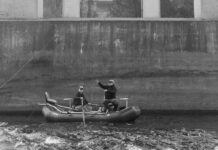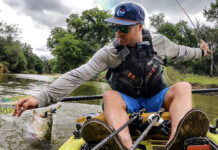Growing up near the ocean, I spent quite a bit of time fishing the surf, rock jetties, harbors, and on deep-sea charter boats in southern California. But one day, while exploring my neighborhood, I found a small pond and decided to fish it with my deep-sea spinning combo. I was using corn for bait, and it didn’t take long before it didn’t take long to get a bite, and honestly, when I landed the fish, I didn’t know what it was. I would soon find out from looking in an encyclopedia of fishing that it was a nice largemouth bass. I also found out that you could use lures to catch them. I went to a tackle store and purchased a couple of inline spinners, the Mepps minnow and a yellow Rooster Tail. I also purchased a smaller spinning combo. I went to this pond several times more and caught numerous largemouth.
Fast forward several decades and bass fishing has reached the point where I’ve become obsessed with catching the number of fish to correspond with the year. For example, the last two years I’ve caught at least 2,023 and 2,024 bass, respectively, and recorded them all on the TourneyX app. I’ve also traveled the country extensively, entering high-stakes kayak fishing tournaments. My favorite part of bass fishing though is figuring out the pattern for catching these fish. Of course, like many others, it’s the feel of the bite and tug that drives me to want to fish even more.
From what I’ve experienced, the most important aspect is to keep things simple. Elements to understand when you are learning how to catch bass are the time of year, type of fishery, weather, and of course, what gear to bring along.
Bass fishing basics
Across the planet, the black bass is sought after by millions of anglers as a sportfishing favorite. This usually includes the most popular largemouth bass, smallmouth bass, and spotted bass, which can grow to behemoth sizes, especially in the southern hemisphere. There are literally thousands of tournaments that focus strictly on bass each year, and It can be quite the challenge to catch them at times, and it’s always rewarding.
Bass behavior
For the most part, it has been humorously said that bass only have two things on their mind: eating and reproduction. It is also well known that bass are opportunistic in their eating habits. There are numerous smaller creatures that live on or in the same waters as bass, and if it will fit in their mouth, a bass will eat it. These creatures might include crawdads, other fish, bugs, worms, birds, snakes, and even small rodents. Bass are extremely skilled at ambushing prey but may also school up in open water and corral their prey.
The largemouth and spotted bass have a lateral line that is basically a sensory system that runs alongside the body of the bass. This lateral line can detect the tiniest of vibrations and any changes in water pressure that help the largemouth survive even in the murkiest water. So when you throw that bladed jig or crankbait they can feel the vibration, and because of their instinctive nature, they will usually attack and try to eat it.
Smallmouth mostly rely on sight and smell to find and eat their prey. With stained or murky water, the smallmouth uses that keen sense of smell to zone in on their prey.
As the water warms in the spring, the appetite for the bass grows exponentially and they will constantly feed throughout the day before the spawn occurs. Even if they have just eaten a large meal their instincts still have them striking at anything moving nearby. And in the fall, as the water temperatures drop and the days get shorter, the bass will once again feed voraciously before winter hits.
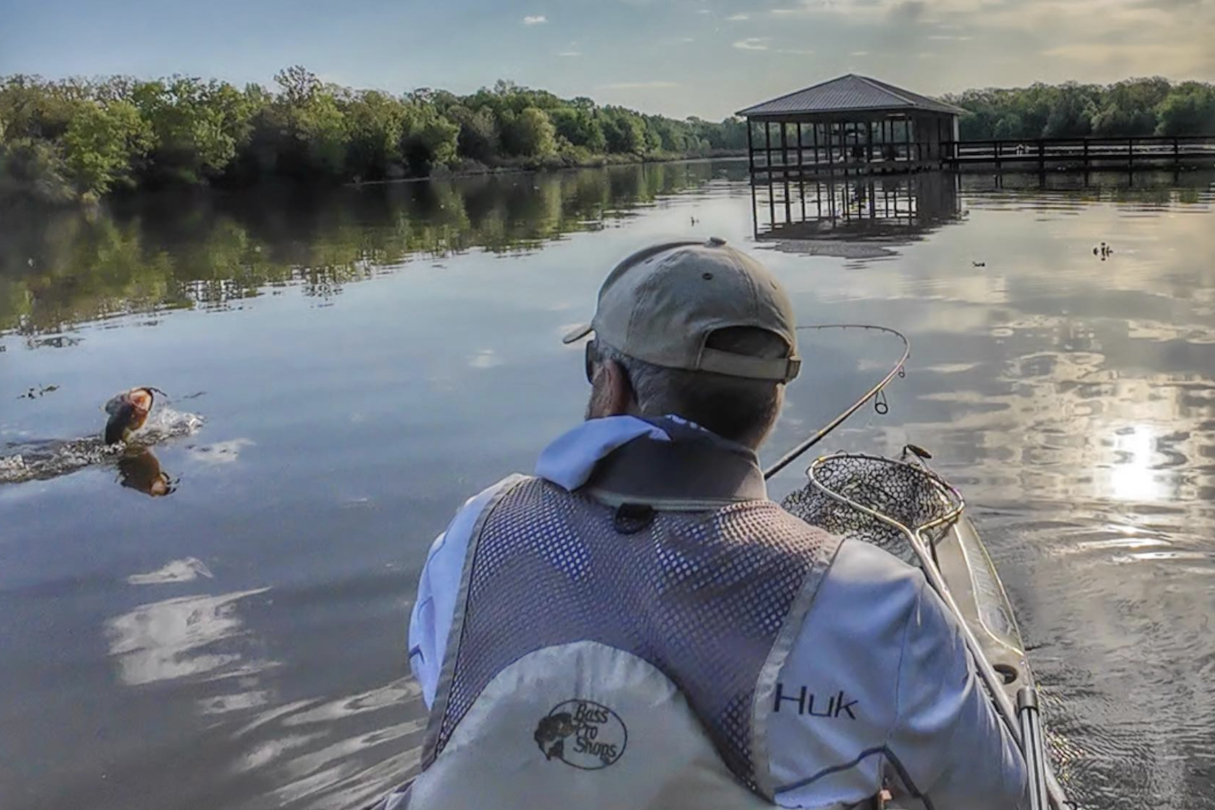
When to fish for bass
Bass can be caught any time of day. While there are major feeding times, bass, like us, may like to hit the drive-thru between meals for a quick snack. There is always an opportunistic feeding bass ready to strike your lure, just keep a few thoughts on time of day in mind then keep casting.
Early morning
Some of the best times to fish for bass are early in the morning when baitfish and other prey become more active. These times of lower light help the bass to see better than during the brighter times of the day. You might observe them feeding on the surface during these times, making them easier to find and catch.
Late evening
Just before the sun goes down is another great opportunity to catch bass. As the water cools down the bass may become more active with that last hour of sunlight being called the “golden hour” for catching fish.
Midday
Now, don’t rule out the middle of the day either. It is during this time when you can find bass concealed under a laydown, in a brush pile, dock, or any other structure that provides shade or protection. They might be less active during this time, but when presented with a potential meal, they will most likely instinctively bite.
Bass fishing through the seasons
Each season of the year provides differences in how we take our approach to catching bass. As the water temperature and length of day change, so do the movements of the bass and their prey.
Two seasons that are usually very productive are spring and fall. Summer and winter are a bit more challenging but bass can still be caught during these seasons as well if you can locate where they are feeding.
Spring
As the water warms in the spring and days start getting longer, the bass will become more active and move into shallow areas for spawning. The bite is usually best just before the spawn and also post spawn as bass replenish their bodies. Areas close to the spawning areas that have a little deeper water, such as points, docks and ditches, can provide for some fantastic pre- and post-spawn fishing. Also, look for wind-blown shorelines in the early spring, as this is where most of the food supply will be drifting to which brings the bass with it.
Summer
As it gets hotter, the bass will usually move to deeper water or shaded areas such as docks, laydowns or overhanging trees. Some of the most productive times to catch bass during the summer are during the early morning or just before dark.
Fall
As the water temperatures begin to drop in the fall, the baitfish and bass will migrate back to the shallower areas, especially the backs of creeks. At first, the mouths of creeks will hold bait and it will slowly move back as fall progresses. Be ready for some great action after a cold night. On warmer days, the bite will be good as well with bass lurking the shallows for prey.
Winter
Again, bass will usually retreat to deeper water and tend to congregate as well near structure. Look for the warmest water you can find, and you will find not only the baitfish but the bass hanging nearby too.
Summer
As water temperatures rise, bass move to deeper water, often staying in areas with good cover and shade. Low light conditions, like early mornings and evenings, can be very productive. Cloudy days can provide for some great topwater action as well.
The key to catching bass each season is finding the appropriate presentation that will entice them to bite.
Where to fish for bass
Bass are in just about every part of the country, whether it be a pond, stream, river or lake. There are a wide variety of black bass anglers pursue, with the main three being largemouth, smallmouth, and spotted bass. Bass are known to try and conceal themselves and attack their prey by surprise. With this in mind, any structure a body of water has to offer you will most likely find a bass lurking in the shadows. Types of structure might include rocks, laydowns, standing timber, docks, heavy vegetation, rip rap along the shoreline and anything else a bass can hide behind.
If there are baitfish, crawfish, or other small creatures around, you are sure to find bass in the area as well. Water with a little more color to it can help fish conceal themselves, giving them a chance to surprise their prey.
If there is a current, bass will usually reside out of it but nearby, looking for an easy meal that passes by them. As an angler gains more experience they will learn to read these areas and cast their bait accordingly.
The key to success in catching bass is to cast your lure in those hard-to-get-to places bass might be hiding. This might be in the midst of heavy brush or laydowns in shallow water. Bass love to hide under docks also, and if you can learn to skip your lure under them you are certain to find a lunker.
As mentioned above, some bass will also take to the deeper water, especially during the hot months of summer. This is where sonar can play a huge role in finding them, as well as deep diving crankbaits and Carolina rigs.
Another key element in finding bass is to look for transition areas like bluff rock walls that change abruptly to a pea gravel shoreline. Main points on lakes are a great area to target bass. They will come up to feed in the shallow areas of the point and then retreat to the deeper water nearby afterward. Or a shallow area that has deeper water nearby. Bass love to hang out on the ledges of these areas before moving into the shallower areas to either spawn or feed.
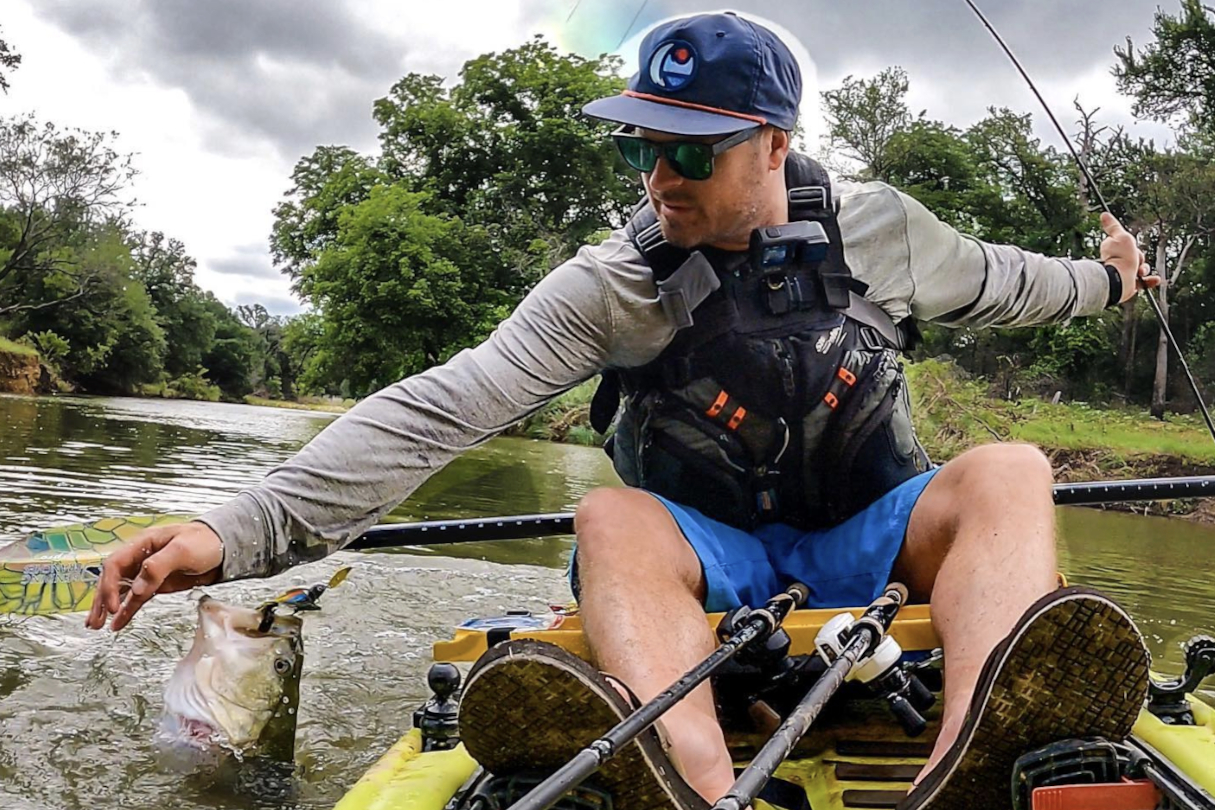
Bass Fishing Setups
There are basically two styles of bass fishing among anglers. They include power and finesse fishing. For many years power fishing has been very popular among bass anglers. There were a few anglers who used a spinning rod for finesse fishing during these times, but with the advancement of sonar technology and forward-facing sonar there has been a huge movement in using finesse tactics to catch bass in the open water areas of lakes where big bass tend to roam.
Here are a few ideas to ponder before heading out with your hard-earned money to purchase a rod and reel for bass fishing.
Spinning rod and reel
You might consider a spinning combo for starters. They are easy to use and very versatile. A 6’6” to 7’0” rod can meet most needs. A medium rod with a fast tip is a great starter rod. For the reel you might consider a 2500 or 3000 series spinning reel.
The spinning combo is a perfect setup for throwing lighter baits and would be considered a finesse approach. There is less chance for a backlash compared to baitcasting reels and great sensitivity for feeling bites. The ability to make long casts, especially in the wind, makes the spinning combo a good choice, especially for the beginning angler. Another major difference is the ability to use a wide variety of lures and the affordability of the spinning combo compared to the baitcast combo.
Baitcasting rod and reel
If you’re interested in power fishing, an angler might purchase a baitcasting rod and reel. The baitcast will give the angler the ability to control the distance of their cast, which helps to place their lure exactly where they want. When fishing small spaces this type of combo can really come in handy.
The baitcast combo is primarily designed for a heavier line, which can throw heavier lures and pull bass from the dense vegetation or quickly from under a dock or lay down. One advantage the baitcast reel has is that there is less line twist in how the spool operates, however, it does take a little more practice to master than the spinning combo. They can be used for flipping and pitching into bushes, laydowns, and around docks more easily than the spinning combo. Baitcasters also have higher gear ratios available so that retrieves are conducted very quickly.
When looking for the best combination of a baitcast rod and reel, I reached out to ask legendary kayak angler Drew Gregory, who mentioned he looks for at least a 7’0 medium-heavy rod for power with a fast tip when throwing single hook lures such as bladed jigs, swim baits, and Texas rigged baits among others. He recommends that the angler avoid moderate and medium actions for this type of presentation. Using a longer rod gives the angler a chance to use a two-handed cast from the kayak, which adds more distance. It’s good to have the rod butt under the armpit with these longer rods for better leverage landing fish.
“The extra length in a rod butt will tuck into your body and help with casting and setting the hook,” Gregory said. Using a braided line can aid in getting a quicker hook set as your kayak can easily be moved by a larger fish, creating slack in your line. With no stretch in your line there is a better chance of keeping the fish pinned.
The most widely used reels for this type of presentation usually have a 7:1 ratio or higher. You will want to look for a reel that has a smooth drag system, good casting distance, extra line capacity, and an excellent braking system that prevents backlashes, especially in the wind.
When using lures such as the crankbait or jerk baits, a medium- or moderate-sized rod with a fast tip can be more productive for hooking and landing fish. For your reel, there is a vast selection to choose from, with most anglers choosing from a 5.0:1 to 7.1:1 gear ratios depending on what they are using for a bait.
Line for bass fishing
When it comes to line there are a multitude of options. Let’s break down the major categories of fishing lines first. The three types of line most commonly used for bass are monofilament, fluorocarbon, and braid. Each has its own advantages. It is imperative that the right line is chosen for the style of fishing the angler prefers.
Monofilament
Monofilament is the most common type of fishing line and can be used in a variety of presentations. It is most commonly known for its stretching ability and strong knot strength. One thing to remember about mono is that it floats. It works very well with topwater lures that float, soft jerk baits, lures with treble hooks where a bass can throw a lure, and the Carolina rig leader, which helps keep the bait up off of the bottom of the lake.
Fluorocarbon
Fluorocarbon fishing line is very popular among bass anglers today, mainly for its abrasion resistance and stealthy appearance under the surface of the water. It has great sensitivity, and with its higher density over mono it will sink in the water. Flouro is widely used as a leader material for finesse fishing in clearer water among anglers.
Braided line
Braided line is made up of several strands of fiber woven together to result in a line with no stretch. It has exceptional abrasion resistance and is very durable. By not having stretch, it has a strong sensitivity to feel the slightest bite. It is a good choice for fishing deeper water, thick vegetation, and bigger fish. Because braid is more visible, many anglers combine a fluorocarbon leader to the bait.
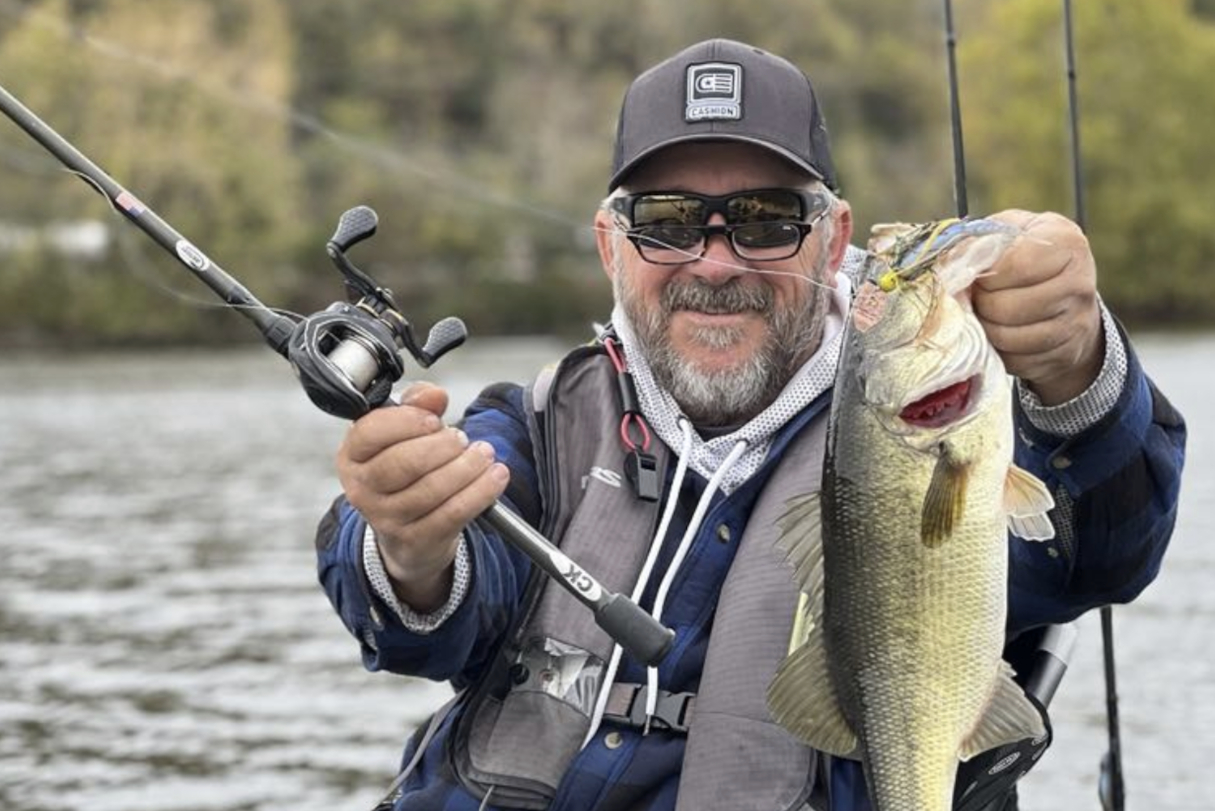
Presentations for bass
It has been said many times that “Lures catch more fishermen than catch fish.” There are literally thousands of options when choosing a lure for catching bass. The key questions are, how do you want to catch them, and what do you have the most confidence in throwing?
Lures simplified
Topwater
One of the most exciting ways to catch bass is with a topwater lure. This could include a plastic frog, popper, buzzbait, walking bait, or prop style bait.
Plastic
A traditional method is to use plastics such as worms, craws, lizards, and creature baits that are molded with colors that will attract bites from bass.
Moving
The power fisherman loves to throw moving baits that will usually get an instinctive bite from bass. These can include crankbaits, bladed jigs, lipless, and the spinnerbait which has survived the test of time.
Bass rigs and tactics
Setting up a rig can be very simple to do. The first thing to consider is selecting the best rig for the type of bass fishing you are going to do. For instance, it would be difficult to fish a jig head minnow in heavy vegetation.
Here are a few basic bass fishing rigs that you can use to have more success out on the water.
The Texas rig is an excellent choice to use in areas that have thick vegetation, laydowns, rock, or other structure that is difficult for most open hook presentations. It is very simple to rig by placing a bobber stopper as a peg on the line and then adding a bullet-style weight just below it. You can also adjust the weight to the desired distance from the bait depending on your preference.
The legendary Carolina rig, also known as the “ball and chain,” is a very effective presentation when fishing deeper hard bottom water. This setup allows the angler to feel the bottom on flat areas and anywhere there is structure. As it is retrieved, it gives the impression of a small creature moving along the bottom. What is really cool is when the weight above the bait gives a clicking sound as it hits hard structure. The setup is very easy and many anglers have their own preference.
The drop shot rig is primarily used in clearer water and fished vertically for suspended fish below, especially when the bite gets tough. Adding sonar to this finesse approach will greatly enhance your ability to target bass below. The drop shot is very simple to use. Just drop it down above the bass you are targeting and keep the bait in position with little movement except some very subtle twitches and pauses of the rod.
The jig-head minnow rig has been very effective, especially with the advent of forward-facing sonar. It can be fished both directly below and cast to precise locations for roaming bass. With this presentation all you need is a jig head that resembles a minnow, and there are literally hundreds to choose from on the market. You will also need a trailer, such asa plastic minnow. In this presentation you are mimicking a small baitfish that a bass won’t be able to resist. Lighter lines are usually used on a spinning combo with a good drag system.
The wacky rig is a longtime favorite among anglers of all ages. This simple setup includes a Senko or stick-style plastic worm and either a drop shot hook or wacky-style hook. The enticement comes from the slow-sinking action of the worm after it hits the water. Skipping it to the target area is even more effective. On the descent the worm usually has a fluttering action. Sometimes, with highly pressured fish it might be necessary to “deadstick” the worm after it falls to the bottom, producing more bites. This presentation is very effective around docks, laydowns and over spawning flats.
The Neko rig is fast becoming one of the most popular rigs out there, even though it has been around for decades. It started out in Japan and was termed “the presentation that catches fish like a vacuum cleaner.” Neko, means “cat” in Japanese and the retrieval of it is somewhat like a cat clawing action when rigged appropriately. The Neko rig can be used just about anywhere and any time of the year. You can catch bass on the fall, “deadsticking” it, or even swimming the bait through the water column for the best results.
The best part of bass fishing is figuring out the puzzle each time out. The key to your success in catching bass is knowing the conditions of the water based on the time of year and finding key elements that will enhance your chances. Time on the water is your ally. Find a presentation or two that gives you the most confidence and start there.



